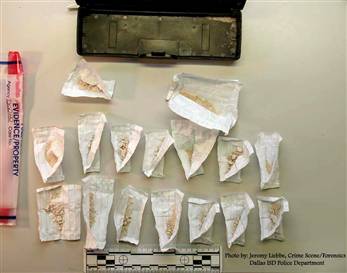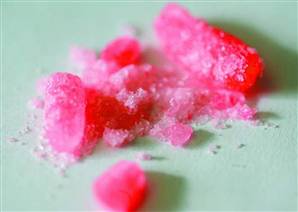Menstuff® has compiled the following information on Meth
Usage.
Drug dealers peddling new kid-friendly
mixes
Man chronicles his death by meth
use
Street Durgs
Teen Drug Abuse Articles
What are the physical and social effects of
methamphetamine and who is using it?
What are the physical and social effects of
methamphetamine and who is using it?
The drug is made easily in clandestine laboratories with mostly inexpensive ingredients. Meth has been the most prevalent clandestinely produced controlled substance in the United States since the 1970’s. This combination makes meth a drug with a very high potential for widespread distribution and abuse.
As a powerful stimulant, meth can increase wakefulness and physical activity while decreasing appetite. A brief, intense sensation is reported by users who snort or inject the drug. Both the rush and the high are believed to result from the release of very high levels of the neurotransmitter dopamine into areas of the brain that regulate feelings of pleasure (Drug Information).
Initially, the effects of meth can be characterized by increased mental and physical well-being. With increased doses and/or chronic use, the risk of toxicity increases and the user may experience irritation, outbursts of anger, paranoia, delusional thinking and visual or auditory hallucinations.
Significant numbers of American youth engage in heavy meth use and these numbers continue to increase. Causing damage to property and causing injury to themselves are among the most common problems associated with meth use. Tolerance for meth can develop with chronic use. In an effort to intensify the desired effects, users will take higher doses more frequently. In many cases, abusers go without food and sleep while indulging in a form of binging known as a “run,” injecting as much as a gram every two to three hours over a several day period. This will continue until the user runs out of the drug or is too disoriented to continue. Chronic meth abuse can result in inflammation of the heart lining as well as progressive social and occupational deterioration. Psychotic symptoms can sometimes persist for months or years after use has ceased (drug info).
Fetal exposure to meth is a significant problem in the United States. Extensive research has indicated that abusing meth during pregnancy may result in increased rates of premature delivery, abnormal reflexes and extreme irritability. Congenital deformities have also been linked to meth abuse during pregnancy. A potential risk to meth users is the possibility of lead poisoning. Lead acetate is often used as a reagent in illegal meth production.
Statistics show that between 1998 and 2002, death from methamphetamine overdoses rose 125 percent. Between 1998 and 2000, meth related emergency room visits doubled. In the past few years, the use of this drug has increased dramatically in teenagers from 12 to 17 years old. The internet has hundreds of web sites that provide the recipes and places to purchase ingredients for manufacturing the drug. Toxic ingredients, such as battery acid and drain cleaner are often used to produce meth (NCADI).
A key explanation for the increase in use is the proliferation of a youth rave culture that encourages hard drug use as a means to personal freedom, self-discovery, and peer acceptance. Adding to this problem is the “non-alcohol” after hour’s club. These all night rave clubs are not subject to standard law enforcement procedures. Police have no legal authority to enter these premises as they do in the case of regularly licensed alcohol serving establishments, without first obtaining a search warrant or receiving permission from the owner or operator.
Experimentation with crystal meth has become commonplace for socially active young people irrespective of their economic status and social background. We live in a society where being thin and beautiful has become increasingly important to many of our youth.
One of the reasons for using meth is the misguided idea these kids have regarding weight loss. Adolescents do have dramatic weight loss when using meth for any substantial length of time. Since meth decreases the appetite, the weight loss seems almost effortless. However, this is an extremely dangerous way to try to control their weight. As soon as these youth stop using meth, the weight comes back on very quickly. The youth begins an increased usage of the drug in an attempt to control their weight, as they try to live up to an impossible standard the media and advertisers have pushed upon them.
Prevalence and patterns of substance abuse by urban street youth vary from city to city but appear to be much higher than student use. A pattern of increased use with age is clearly related to adolescent psychological development, during which peer relationships assume greater importance. Transition between school levels clearly represents a point of vulnerability for some students (Preventing Substance Use Problems Among Young People).
Through its stimulant effects, meth produces a positive feeling, but when it wears off, it leaves a person with the opposite feelings. This is because of the suppression by the drug of the normal production of adrenaline. A chemical imbalance is created and the result is irritability, which physically demands more of the drug to feel normal. This pleasure/tension cycle leads to a loss of control over meth and the end result can be full blown addiction (Alcoholism and Substance Abuse, 349).
Usually a person who uses meth never gets as big a “high” as he or she did the first time. As tolerance develops to the euphoric effects, larger and larger doses of the drug are needed to get a pleasurable effect. This increases the risk of toxicity, overdose, and death. When the pleasure areas in the brain are artificially stimulated it leads to increased confidence in meth, and less confidence in the normal rewards of life.
The things that used to be interesting are replaced by people, places, and activities involved with using meth. More and more confidence is placed in the drug and the result is a lack of interest in other areas of life. The subconscious memory learns that the drug is not something that is just pleasurable, but something that is needed just in order to function and make it through the day.
Works Cited
Bratter, Thomas E., and Gary G. Forrest. "Alcoholism and Substance Abuse Strategies for Clinical Intervention." New York: The Free Press, 2000.
“Drug Information” Narconon International 2002. 17, Nov.
2004 www.narconon.org/druginfo/methamphetamine_meth.html
![]()
Marcelle, George. National Clearinghouse for Alcohol and Drug Information. Maryland: Prentice Hall, 1999.
“Preventing Substance Use Problems Among Young People”
Health Information 2003.17, Nov. 2004 sesc/eds/publications/substanceyoungpeople/chapter2.htm
![]()
Man chronicles his death by meth
use
A former trucker whose documentary chronicled an agonizing descent as methamphetamine ravaged his body has died, optimistic to the end that his story would keep others from the highly addictive stimulant.
“He was extremely satisfied, wanting to do more in getting the word out and showing kids what meth harm does. We didn’t get to that point,” his father, Jack Bridges, said shortly after the 35-year-old died Monday at a hospital in Cape Girardeau.
“He didn’t want anyone to go through what he did,”
his father said.

Shawn Bridges drew global attention last year for “No More Sunsets,” a 29-minute film shot by a former southern Illinois television videographer at Bridges’ request.
By his family’s account, Bridges already had died at least twice, his heart so damaged by years of using meth — a concoction that can include toxic chemicals such as battery acid, drain cleaner and fertilizer — that it stopped and had to be shocked back into beating.
The documentary shows Bridges mostly bedridden, his constant companions a catheter and feeding tube.
“I’d say he’s got a 34-year-old body on the outside with a 70-to 80-year-old man on the inside,” his father told The Associated Press last May.
Roughly 28,000 people sought treatment for meth addiction across the country in 1993, accounting for nearly 2 percent of admissions for drug-abuse care, according to the federal Substance Abuse and Mental Health Services Administration.
Just a decade later, the meth-related admissions numbered nearly 136,000 — more than 7 percent of the national total for drug-abuse treatment.
Haunted by brother's death
Family members have said Bridges had been haunted by the dreary day in 1976 when his younger brother Jason, barely a year old, died in a car wreck. Shawn was 4 and nowhere near the accident but still blamed himself, wanting to trade places with his dead sibling, his father said.
A lenient upbringing set Bridges on the road to becoming “a little monster,” his father said. “By 16, the kid was a high school dropout and partier.”
At 26, Bridges had a heart attack that his father blamed on meth’s ability to damage a chronic user’s heart and other internal organs. Bridges learned he had congestive heart failure. Twice, he tried to kill himself, according to family members.
During his final months in a hospital bed, Shawn’s words slurred to guttural sounds when he tried to talk. At times, he spit up blood, and his weight fell dangerously when he couldn’t keep food down. His father said Monday that Bridges developed a urinary tract infection shortly before he died.
“I don’t think people will forget what got him to this point,” said Chip Rossetti, who filmed the documentary. “But what he did with his condition is really the amazing thing.”
Rossetti said 500 to 600 copies of the documentary have been sold, some going as far as Australia. Bridges was also profiled on German television. Rossetti said Monday he plans a sequel, chronicling Bridge’s final year and testimonials by people touched by his awareness effort.
“We wanted to keep him with us a lot longer, but we
appreciate God’s good grace,” Jack Bridges said after his
son’s death. “We’ll still be trying to drive home the
point that these drugs are poison, and that people using them are
heading the same place Shawn has gone.”
Source: www.msnbc.msn.com/id/17808933/
![]()
Drug dealers peddling new kid-friendly
mixes

In their quest to lure new, younger clientele, drug dealers are mixing their wares with over-the-counter pain remedies and other familiar products — even candy — and peddling them under non-threatening names.
One such concoction, a blend of black tar heroin and Tylenol PM that goes by the name “cheese,” has been linked to the deaths of 19 teenagers in Dallas, including two 15-year-olds.
“If you’re a drug dealer you have to target a new audience all the time,” said Garrison Courtney, a U.S. Drug Enforcement Agency spokesman. “It’s Marketing 101 for drug dealers.”
Examples of the drug-mixing strategy also include candy laced with marijuana and, in several states, flavored methamphetamine. In Arkansas recently, a mix of meth and strawberry-flavored powder normally used to create a children’s milk drink turned up under the name “Strawberry Quick.”
“They’re calling it ‘cheese,’ they’re not calling it ‘heroin,”’ said Dr. Collin Goto, a toxicologist at Children’s Medical Center Dallas. “It becomes much more appealing to younger kids because it doesn’t have the stigma, they’re not as afraid to get started.”
Dallas school district police first became aware of the heroin-mixing trend in 2005, and its become a disturbing local phenomenon since.
“Cheese is just a different makeup for mixing with heroin, but it’s still heroin,” said Dr. Jeffrey Barnard, chief medical examiner for Dallas County. “It’s the heroin that’s the problem.”
Cheap and needle-free
Beyond the innocuous name, several other factors appear to be driving the popularity of cheese. Kids often buy the drug from other kids. It’s affordable, selling for about $2 a dosage. And it is snorted rather than injected.
During the 2005-2023 school year, the Dallas school district police arrested 90 students for possession of the heroin-Tylenol PM mixture. The number has soared during the current school year. Through February, 122 have been arrested. The average age of those arrested: 14.

The latest meth cut, known as "Strawberry Quick," uses a powdered drink mix to give the drug a pink coloring. The sweetness of the powder can make meth more palatable and partially masks its harsh chemical taste.
“The resurgence of heroin in society in 11- to 16-year-olds — that’s unprecedented,” said Julian Bernal, deputy chief of narcotics for the Dallas police, who makes six to 12 arrests a month for possession of cheese heroin.
“Hopefully we can try to contain it,” said Dr. Sing-Yi Feng, another toxicologist at Children’s Medical Center Dallas. “The concern is that the stuff is pretty cheap. It’s easy to use.”
Experts say cheese usually has about 2 percent to 8 percent heroin mixed with the Tylenol PM — which contains acetaminophen and diphenhydramine — or similar over-the-counter drugs.
‘Cheese’ arrests rising
Gary Hodges, deputy chief of the Dallas school district police, said cheese arrests in the district have nearly equaled those for marijuana, still the leading substance involved in drug arrests.
Authorities say they are just now beginning to understand how widespread the mixture has become and the toll it is taking on Dallas area youth. Even the exact number of cheese heroin-related deaths was not known until The Dallas Morning News analyzed medical examiner records and published the results last month.
“Basically, it flew under the radar screen,” said Zachary Thompson, director of Dallas County Health and Human Services and a member of the Dallas County task force on cheese.
Most of the victims are male, and involve nearly equal numbers of white and Hispanic youth.
Dave Cannata’s 16-year-old son, Nick, died in June 2005, with heroin and diphenhydramine in his system. Nick Cannata, who had been in rehab for a drug problem the summer before, was found dead in his bed in Coppell, just outside of Dallas.
He had spent the day building a deck with his father before going to a friend’s house. Dave Cannata said he knew something was wrong when his son returned home that night, but he decided to delay a confrontation.
“If I had to do it over again, I wouldn’t hesitate to pick up the phone and call 911,” said Cannata. “It’s alarming the epidemic proportion of kids that are messing with this stuff.”
Olga Sanchez agrees. She thought her 15-year-old son had stopped using the mixture. But this spring, Oscar Gutierrez’s brother found the eighth-grader at a Dallas middle school dead in bed.
“He was very purple. He was very cold, cold,” said Sanchez, who had been attending drug counseling with her son since discovering his cheese habit last fall.
“I would like for kids to realize that lots of other kids
have died, that they should look for help, that they could lose their
life,” she said.
Source: http://www.msnbc.msn.com/id/18557266/wid/11915773/
![]()
Source: www.teendrugabuse.us/methamphetamine.html
![]()
|
|
|